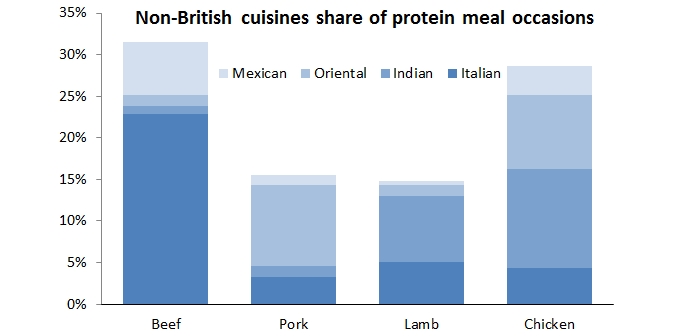Pork is losing out in the continuing rise of the international foods which are now being preferred by British consumers, according to AHDB Pork.
Noting that global travel and population diversification has influenced the types of foods British consumers eat, AHDB Pork says that while beef and chicken have benefited from recent changes, pork definitely hasn’t.
“British consumers are still most likely to opt for traditional British meals or protein-centred dishes (like meat, potatoes and vegetables) over ethnic/world cuisines,” said AHDB Pork. “But the lines are blurring and there are new traditions.”
Compared to two years ago, for example, “Meat and two veg” type options are down by over 2% while ethnic and continental dishes are up almost 5%, a long-term shift which comes from increased population diversification and travel. In addition, the non-UK born population has not only grown, to around 13% of the total population, but has also diversified.
“Beef has no doubt benefited from both long-term and more recent changes in cuisine preference,” said AHDB Pork. “Italian cuisine alone accounts for almost a quarter of all meal occasions featuring beef, with the majority of this being Spaghetti Bolognese (even though the original dish would have used pork mince). Mexican meal options also give a boost to beef consumption, accounting for 6% of meal occasions.
“Beef’s strong association with these types of dishes isn’t replicated for pork (or lamb) but it is for chicken. Almost half of all Indian dishes feature chicken and the taste perception of chicken is, no doubt, boosted by its association with dishes such as this, rather than the actual flavour of the meat. This dish association, particularly for pork, is something the sector ought to strive for, positioning it as a direct alternative to chicken.”
AHDB Pork also points out that it’s not just in the UK that traditional British cuisine is losing out.
“Chinese and Italian cuisines have the strongest global appeal, whereas British cuisine is not eaten frequently outside the UK,” it said. “When comparing consumption of native cuisines, British consumers are some of the least likely to eat their native food on a regular basis. The UK and USA’s regular consumption of other cuisines (particularly Chinese and Italian) is greater than other countries.
“This highlights how vulnerable the British cuisine is on a global scale, given that it’s not favoured in other countries.”




